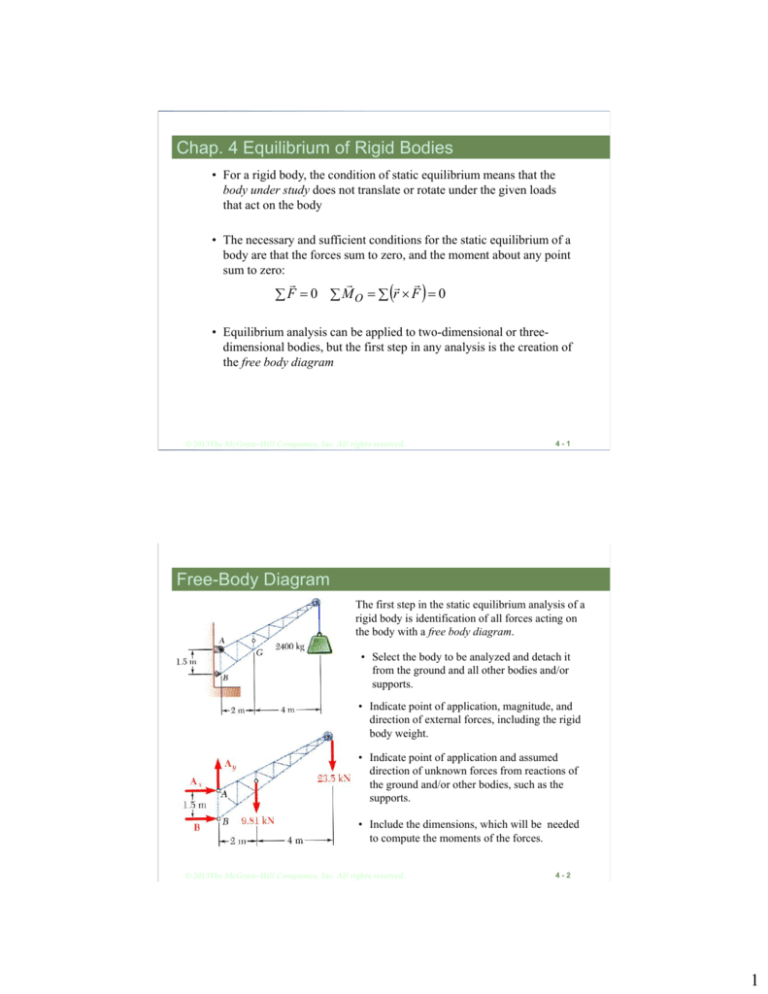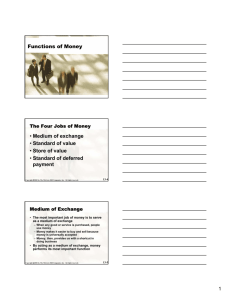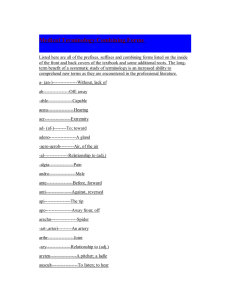
Chap. 4 Equilibrium of Rigid Bodies
• For a rigid body, the condition of static equilibrium means that the
body under study does not translate or rotate under the given loads
that act on the body
• The necessary and sufficient conditions for the static equilibrium of a
body are that the forces sum to zero, and the moment about any point
sum to zero:
F 0 M O r F 0
• Equilibrium analysis can be applied to two-dimensional or threedimensional bodies, but the first step in any analysis is the creation of
the free body diagram
© 2013The McGraw-Hill Companies, Inc. All rights reserved.
4-1
Free-Body Diagram
The first step in the static equilibrium analysis of a
rigid body is identification of all forces acting on
the body with a free body diagram.
• Select the body to be analyzed and detach it
from the ground and all other bodies and/or
supports.
• Indicate point of application, magnitude, and
direction of external forces, including the rigid
body weight.
• Indicate point of application and assumed
direction of unknown forces from reactions of
the ground and/or other bodies, such as the
supports.
• Include the dimensions, which will be needed
to compute the moments of the forces.
© 2013The McGraw-Hill Companies, Inc. All rights reserved.
4-2
1
Reactions at Supports and Connections for a Two-Dimensional Structure
• Reactions equivalent to a
force with known line of
action.
© 2013The McGraw-Hill Companies, Inc. All rights reserved.
4-3
Reactions at Supports and Connections for a Two-Dimensional Structure
• Reactions equivalent to a
force of unknown direction
and magnitude.
• Reactions equivalent to a
force of unknown
direction and magnitude
and a couple.of unknown
magnitude
© 2013The McGraw-Hill Companies, Inc. All rights reserved.
4-4
2
Practice
The frame shown supports part of
the roof of a small building. Your
goal is to draw the free body
diagram (FBD) for the frame.
(Neglect the weight of objects.)
© 2013The McGraw-Hill Companies, Inc. All rights reserved.
4-5
Equilibrium of a Rigid Body in Two Dimensions
• For known forces and moments that act on a
two-dimensional structure, the following are
true:
Fz 0 M x M y 0 M z M O
• Equations of equilibrium become
Fx 0 Fy 0 M A 0
where A can be any point in the plane of
the body.
• The 3 equations can be solved for no more
than 3 unknowns.
• The 3 equations cannot be augmented with
additional equations, but they can be replaced
Fx 0 M A 0 M B 0
© 2013The McGraw-Hill Companies, Inc. All rights reserved.
4-6
3
Statically Indeterminate Reactions
• More unknowns than
equations
• Fewer unknowns than • Equal number unknowns
and equations but
equations, partially
improperly constrained
constrained
© 2013The McGraw-Hill Companies, Inc. All rights reserved.
4-7
Sample Problem 4.1
• Determine B M A 0 : B1.5m 9.81 kN2m
A fixed crane has a mass of 1000
kg and is used to lift a 2400 kg
crate. It is held in place by a pin
at A and a rocker at B. The
center of gravity of the crane is
located at G.
Determine the components of the
reactions at A and B.
B 107.1 kN
23.5 kN6m 0
• Determine the reactions at A
Fx 0 : Ax B 0
Ax 107.1 kN
Fy 0 : Ay 9.81 kN 23.5 kN 0
Ay 33.3 kN
© 2013The McGraw-Hill Companies, Inc. All rights reserved.
4-8
4
Sample Problem 4.4
The frame supports part of the roof of
a small building. The tension in the
cable is 150 kN.
Determine the reaction at the fixed
end E.
Fx 0 : E x
4.5
150 kN 0
7.5
Fy 0 : Ey 4 20kN cos 36.9 o 150kN 0
M E 0 : 20 kN7.2 m 20 kN5.4 m
20 kN3.6 m 20 kN1.8 m
6
150 kN 4.5 m M E 0
7.5
© 2013The McGraw-Hill Companies, Inc. All rights reserved.
Practice
FA 2100 lb FB
M B 0.
-FA (60 in.)+2100lb (40 in.)-900 lb (50 in.)=0
FA=650 lb, so the reaction at
A 2100-lb tractor is used to
each
wheel is 325 lb
lift 900 lb of gravel.
Determine the reaction at
each of the two rear wheels Fy = 0 FB 2350 lb,
or 1175 lb at each front wheel
and
twoMcGraw-Hill
front wheels
4 - 10
© 2013The
Companies, Inc. All rights reserved.
5
What if…?
W=?
2100 lb
• Now suppose we have a different
problem: How much gravel can this
tractor carry before it tips over?
FB
W
2100 lb
FB
© 2013The McGraw-Hill Companies, Inc. All rights reserved.
4 - 11
Equilibrium of a Two- or Three-Force Body
© 2013The McGraw-Hill Companies, Inc. All rights reserved.
4 - 12
6
Sample Problem 4.6
A man raises a 10-kg joist, of length 4
m, by pulling on a rope. Find the tension
T in the rope and the reaction at A.
© 2013The McGraw-Hill Companies, Inc. All rights reserved.
4 - 13
Problem 4.64
A 500-lb cylindrical tank, 8 ft in
diameter, is to be raised over a 2ft obstruction. A cable is wrapped
around the tank and pulled
horizontally as shown. Knowing
that the corner of the obstruction
at A is rough, find the required
tension in the cable and the
reaction at A.
© 2013The McGraw-Hill Companies, Inc. All rights reserved.
4 - 14
7
Problem 4.73
A 50-kg crate is attached to the
trolley-beam system shown.
Knowing that a = 1.5 m, determine
(a) the tension in cable CD, (b) the
reaction at B.
© 2013The McGraw-Hill Companies, Inc. All rights reserved.
4 - 15
Equilibrium of a Rigid Body in Three Dimensions
• Six scalar equations are required to express the
conditions for the equilibrium of a rigid body in the
general three dimensional case.
Fx 0 Fy 0 Fz 0
Mx 0 M y 0 Mz 0
• These equations can be solved for no more than 6
unknowns which generally represent reactions at supports
or connections or unknown applied forces.
• The scalar equations are conveniently obtained by applying the
vector forms of the conditions for equilibrium,
F 0 M O r F 0
© 2013The McGraw-Hill Companies, Inc. All rights reserved.
4 - 16
8
Reactions at Supports and Connections for a Three-Dimensional Structure
© 2013The McGraw-Hill Companies, Inc. All rights reserved.
4 - 17
Reactions at Supports and Connections for a Three-Dimensional Structure
© 2013The McGraw-Hill Companies, Inc. All rights reserved.
4 - 18
9
Sample Problem 4.8
8i 4 j 8k
TBD TBD
12
6i 3 j 2k
TEC TEC
7
A sign of uniform density weighs 270
lb and is supported by a ball-andsocket joint at A and by two cables.
Determine the tension in each cable
and the reaction at A.
M
A
rB TBD rE TEC 4 ft i 270 lb j 0
j : 5.333TBD 1.714 TEC 0
k : 2.667 TBD 2.571TEC 1080 lb 0
TBD 101.3 lb TEC 315 lb
A 338 lb i 101.2 lb j 22.5 lb k
© 2013The McGraw-Hill Companies, Inc. All rights reserved.
Sample Problem 4.10
© 2013The McGraw-Hill Companies, Inc. All rights reserved.
10
Problem 4.95
Two transmission belts pass over a
double-sheaved pulley that is attached to
an axle supported by bearings at A and D.
The radius of the inner sheave is 125 mm
and the radius of the outer sheave is 250
mm. Knowing that when the system is at
rest, the tension is 90 N in both portions
of belt B and 150 N in both portions of
belt C, determine the reactions at A and D.
Assume that the bearing at D does not
exert any axial thrust.
© 2013The McGraw-Hill Companies, Inc. All rights reserved.
4 - 21
Problem 4.121
The assembly shown is welded to collar A
that fits on the vertical pin shown. The pin
can exert couples about the x and z axes
but does not prevent motion about or
along the y axis. For the loading shown,
determine the tension in each cable and
the reaction at A.
© 2013The McGraw-Hill Companies, Inc. All rights reserved.
4 - 22
11







